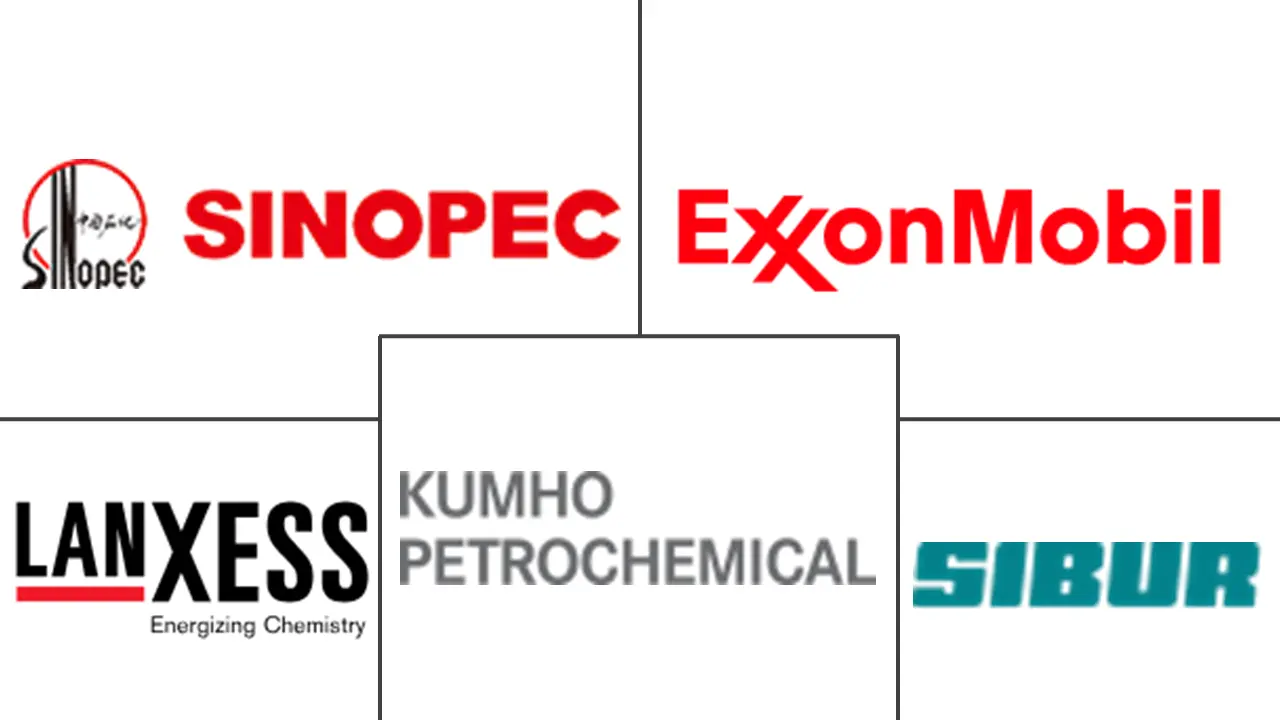Synthetic Rubber Market Size and Share
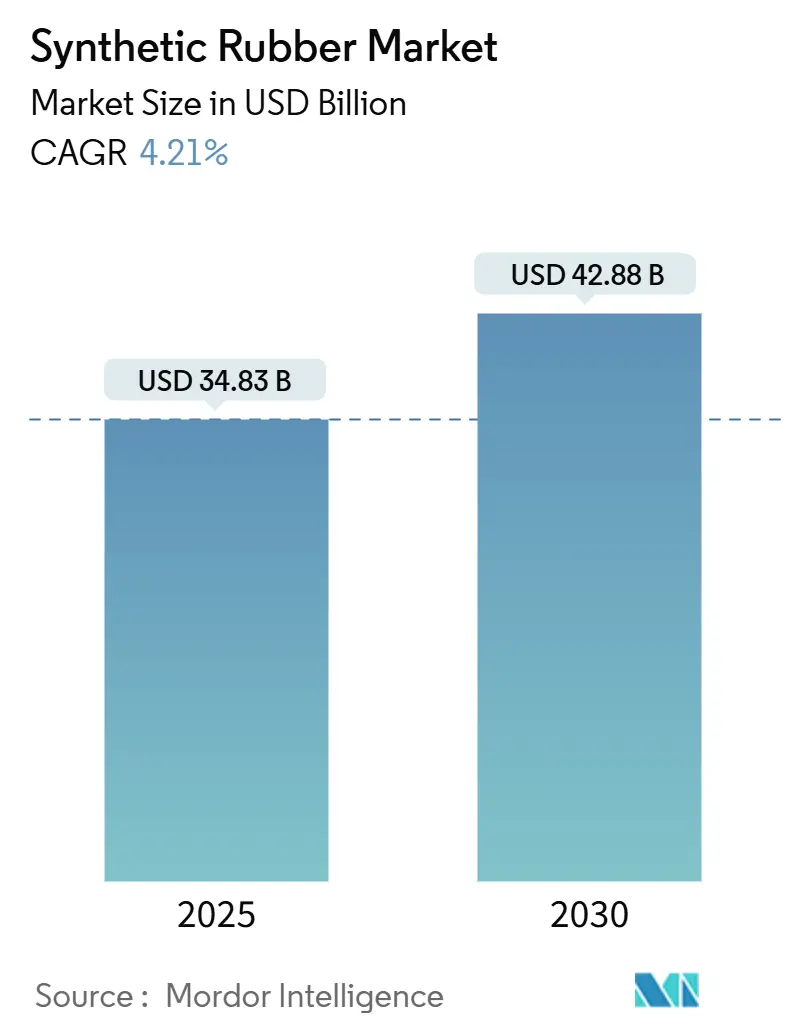
Synthetic Rubber Market Analysis by Mordor Intelligence
The Synthetic Rubber Market size is estimated at USD 34.83 billion in 2025, and is expected to reach USD 42.88 billion by 2030, at a CAGR of 4.21% during the forecast period (2025-2030). Resilient demand from tire producers, industrial manufacturers, and healthcare suppliers underpins this growth even as feedstock prices fluctuate and environmental standards tighten. Rising electric-vehicle (EV) adoption is reshaping product specifications, pushing suppliers toward solution-polymerized grades that deliver lower rolling resistance and extended wear life. Renewable-energy installations are creating new high-value channels for EPDM, while medical and consumer goods segments are broadening the customer base. At the same time, bio-based monomers are scaling rapidly as OEMs chase net-zero commitments, and this transition is compressing the margin window for legacy petroleum-based output.
Key Report Takeaways
- By type, Styrene-Butadiene Rubber held 40% of the synthetic rubber market share in 2024, while EPDM is projected to expand at 5.77% CAGR through 2030.
- By manufacturing process, emulsion polymerization accounted for 60% revenue share in 2024; solution polymerization is advancing at a 5.51% CAGR to 2030.
- By raw material, butadiene captured 50% synthetic rubber market share in 2024; bio-based isoprene is forecast to grow at 8.43% CAGR over 2025-2030.
- By application, tires dominated with a 45% share of the synthetic rubber market size in 2024, whereas industrial goods are rising fastest at a 4.49% CAGR.
- By geography, Asia-Pacific led with 57% revenue share in 2024 and is growing at 4.38% CAGR through 2030.
Global Synthetic Rubber Market Trends and Insights
Drivers Impact Analysis
| Driver | (~) % Impact on CAGR Forecast | Geographic Relevance | Impact Timeline |
|---|---|---|---|
| Surging Demand for High-Performance Tires from EV OEMs | +1.2% | China, Europe, North America | Medium term (2-4 years) |
| Growth of Industrial Rubber Goods in Renewable-Energy Installations | +0.8% | Europe, North America, China | Long term (≥4 years) |
| Advancements in Medical and Healthcare Applications | +0.6% | North America, Europe, Asia-Pacific | Medium term (2-4 years) |
| Shift Toward Bio-Based Monomers in North America Driven by Net-Zero Commitments | +0.5% | North America, Europe | Long term (≥4 years) |
| Growth in Consumer Goods Sector | +0.3% | Global, Asia-Pacific focus | Short term (≤2 years) |
| Source: Mordor Intelligence | |||
Surging Demand for High-Performance Tires from EV OEMs
EVs accelerate tire wear by 20-30% because of heavier battery packs and instant torque, prompting tire makers to specify solution-polymerized SBR that lowers rolling resistance and extends lifespan. Bridgestone’s PeakLife polymer, introduced in late 2024, enhances silica interaction and meets EV durability targets. Continuous procurement from Chinese and European EV assemblers converts this technical requirement into a structural pull on the synthetic rubber market.
Growth of Industrial Rubber Goods in Renewable-Energy Installations
Wind-turbine cables, solar-panel gaskets, and hydroelectric seals rely on EPDM for weatherability and electrical insulation. Studies show UV exposure in marine wind farms can reduce EPDM mechanical properties by 27.67% after 480 hours, spurring compound innovation to preserve field durability[1]Jian-jin Deng, “Multi-parameter Weight Analysis and Comprehensive Performance Evaluation of EPDM Rubber under Ultraviolet Environment,” Journal of Polymer Science, researchgate.net . Capacity additions in offshore wind clusters around the North Sea and China’s eastern seaboard drive incremental demand.
Advancements in Medical and Healthcare Applications
Nitrile gloves, tubing and implantables increasingly specify hypoallergenic synthetic rubber. Beyond gloves, synthetic rubber is increasingly utilized in medical tubing, seals, and implantable devices, where its biocompatibility and customizable properties offer significant advantages. Polyisoprene’s similarity to natural rubber without latex allergens unlocks premium device niches, keeping healthcare margins above commodity tire grades.
Shift Toward Bio-Based Monomers in North America Driven by Net-Zero Commitments
Goodyear and Visolis are commercializing isoprene sourced from non-edible biomass for use in a 70% sustainable-material tire slated for 2025. Parallel development programs at Synthomer and the University of York target broader bio-based elastomers[2]Synthomer plc, “Synthomer Partners with the University of York to Develop Next-Generation More Sustainable Bio-Based Polymers,” synthomer.com. Legislative incentives under the US Inflation Reduction Act and EU Green Deal reinforce capex allocation toward these low-carbon routes.
Restraints Impact Analysis
| Restraint | (~) % Impact on CAGR Forecast | Geographic Relevance | Impact Timeline |
|---|---|---|---|
| Volatility in Butadiene Feedstock Prices from Steam-Cracker Turnarounds | -0.7% | Europe, North America, Asia-Pacific | Short term (≤2 years) |
| Substitution by High-Performance Polyurethanes in Seals and Gaskets | -0.5% | Global industrial users | Medium term (2-4 years) |
| Environmental and Regulatory Concerns | -0.4% | Europe, North America | Long term (≥4 years) |
| Source: Mordor Intelligence | |||
Volatility in Butadiene Feedstock Prices from Steam-Cracker Turnarounds
Steam-cracker shutdowns scheduled in France, the Netherlands, and Italy trim European crude C4 availability and lift butadiene prices, which represent roughly 50% of SBR raw-material cost. Margin squeeze prompts Asian producers to divert cargoes westward, yet logistics constraints and natural-gas price spikes keep volatility high.
Substitution by High-Performance Polyurethanes in Seals & Gaskets
Polyurethane gaskets outperform synthetic rubber on abrasion and load-bearing capacity, capturing a share in mining, construction, and agricultural machinery. The American Chemistry Council quantifies consumer benefit at USD 4.6 billion annually for polyurethane applications in North America, underlining the economic incentive for substitution.
Segment Analysis
By Type: EPDM Surges While SBR Holds Scale
Styrene-Butadiene Rubber (SBR) maintains its dominant position with 40% market share in 2024, primarily due to its extensive use in tire manufacturing, where it enhances traction and wear resistance. SBR remains indispensable for passenger-car treads because it balances grip and abrasion. EPDM, however, advances at 5.77% CAGR through 2030, the fastest among all types, as renewable-energy operators specify it for cable sheathing and sealing. EPDM’s 30–50-year service life in roofing also appeals to construction contractors navigating harsher climate patterns.
Demand diversification intensifies. Polybutadiene Rubber blends with SBR to improve low-temperature flexibility in winter tires, while Isobutylene-Isoprene Rubber supports pharmaceutical stoppers where gas permeability must stay minimal. Polyisoprene attracts catheter and glove makers aiming to eliminate natural-latex allergens. Specialty grades such as NBR and CR find traction in oil-service hoses and flame-retardant cables. This expanding palette lets compounders tailor performance to discrete end-use conditions and retain pricing power.
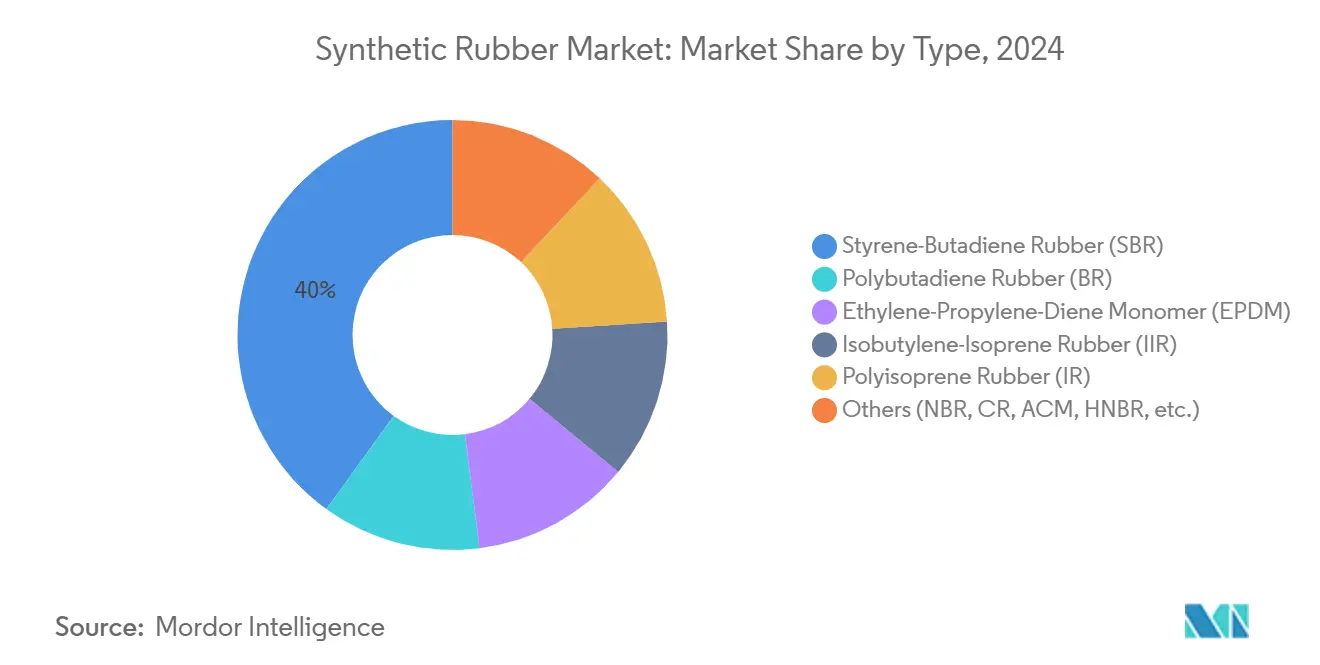
Note: Segment Share of all individual segments available upon report purchase
By Manufacturing Process: Solution Polymerization Accelerates
Emulsion polymerization output accounted for 60% of synthetic rubber market share in 2024 as its reactors are established, cost efficient and highly automated. Yet the synthetic rubber market size attached to solution-polymerized grades will rise at 5.51% CAGR. Linear macro-molecules and narrow molecular-weight distributions produced in solution reactors improve elastic modulus to 18.7 MPa, a critical attribute for high-speed EV tires.
Advanced continuous polymerization uses real-time analytics to adjust monomer feeds, cutting VOC emissions, and enabling precise architecture control. Although its footprint is the smallest, it already underpins niche medical and aerospace demand where reproducibility trumps cost. Producers weigh capex trade-offs between process flexibility, energy intensity and carbon footprint before selecting site expansions.
By Raw Material: Bio-Based Alternatives Gain Momentum
Butadiene held 50% synthetic rubber market share in 2024 because it feeds both SBR and polybutadiene lines. The synthetic rubber market size linked to bio-based isoprene, however, is projected to leap at an 8.43% CAGR, double the overall pace, through 2030. Goodyear’s pilot program with Visolis converts lignocellulosic waste into isoprene for commercial trial blends scheduled in 2025. Concurrently, researchers at the National University of Singapore achieved a 93% Faradaic efficiency when electrosynthesizing butadiene from acetylene, potentially lowering the carbon intensity of C4 supply.
Traditional styrene, ethylene, and propylene streams remain essential. Styrene integrates into SBR for controlled glass-transition temperatures, while ethylene and propylene anchor EPDM chains. Raw-material portfolios now reflect dual priorities: securing volume against cracker outages and climbing the sustainability curve demanded by downstream OEMs.
By Application: Industrial Goods Outpace Tires
Tire and Tire Components absorbed 45% of the synthetic rubber market share in 2024 because global light-vehicle production topped 90 million units. Still, industrial goods will expand at a 4.49% CAGR through 2030, outstripping tire growth. EPDM gaskets in solar farms, nitrile hoses in hydraulic systems, and neoprene expansion joints in bridge retrofits comprise much of this incremental volume. Renewable-energy scale-up adds hundreds of thousands of tons of elastomer demand annually.
Non-tire automotive parts—belts, mounts, and vibration dampers—maintain steady pull, while athletic footwear designers integrate lightweight rubber foams for energy return. Medical devices and premium consumer electronics adopt silicone-modified grades for tactile interfaces. This broadening demand matrix reduces revenue cyclicality historically tied to tire replacement cycles and enables compounders to capture higher value per kilogram.
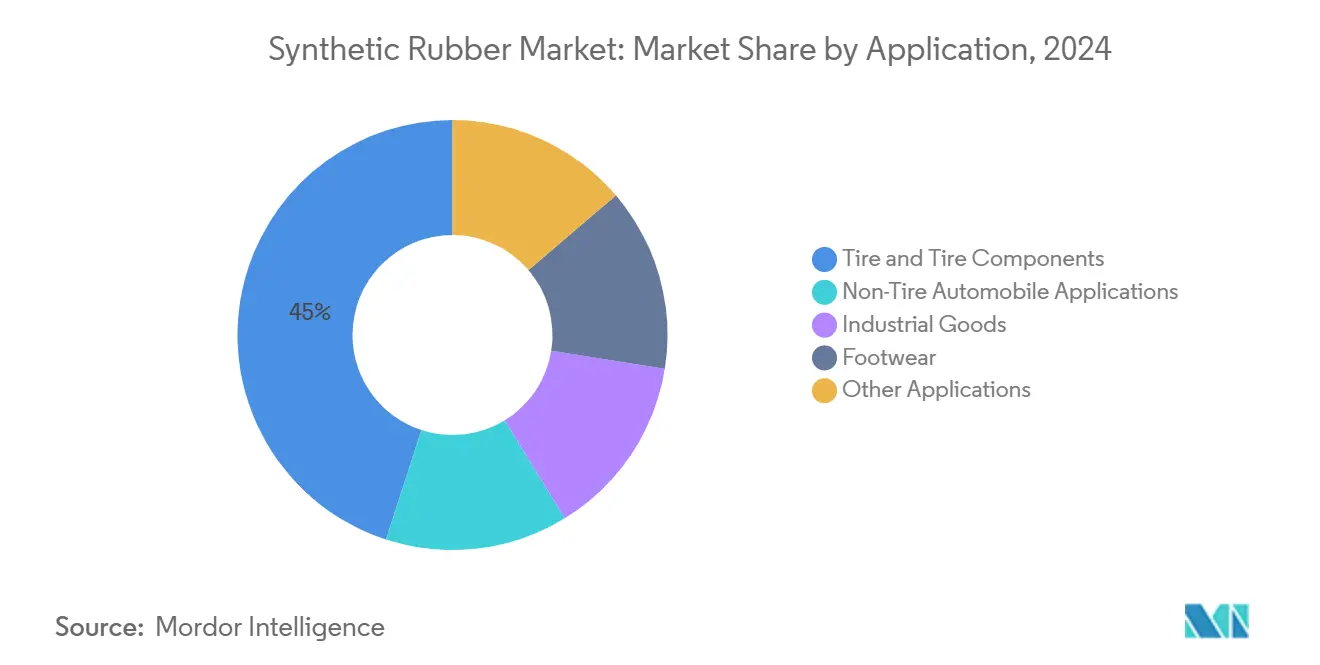
Note: Segment Share of all individual segments available upon report purchase
Geography Analysis
Asia-Pacific commanded 57% of the synthetic rubber market in 2024 and is increasing volume at a 4.38% CAGR to 2030. China anchors this leadership with expansive tire and auto-parts exports, augmented by quickening EV penetration. India, Vietnam and Thailand add regional momentum through greenfield compounding plants. Hyosung’s Vietnam project to derive BIO BDO from sugarcane will create the first integrated bio-based elastane center by 2026, initially rated at 50,000 tons per year.
North America combines advanced R&D with surging bio-content mandates. The National Renewable Energy Laboratory is prototyping reversible crosslinks for recyclable tires, and NC State University co-leads a National Science Foundation center to bolster domestic rubber supply resilience[3]NC State University, “NSF Center Dedicated to Domestic Rubber Production,” ncsu.edu. Large fleet clients such as UPS and Amazon are piloting sustainable tires, creating a pull-through effect for bio-based feedstock producers.
Europe remains a premium hub despite steam-cracker closures tightening butadiene supply. Germany, France and Italy focus on high-performance specialty grades that meet stringent REACH and microplastic regulations. The European Commission’s bio-manufacturing program finances alternative routes for both natural and synthetic rubber to cut import reliance and carbon intensity.
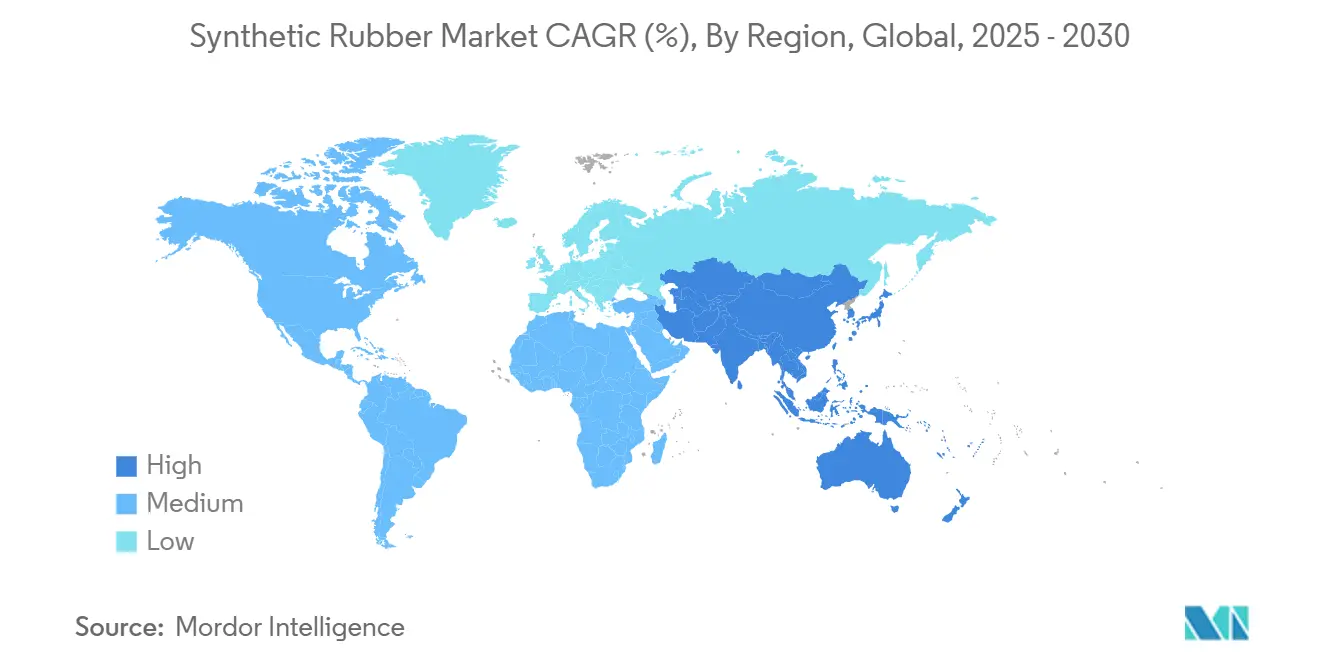
Competitive Landscape
The synthetic rubber market is moderately fragmented, with the top five producers accounting for approximately 36% of installed capacity. Sinopec capitalizes on refinery integration to maintain cost leadership in Asia, while Western manufacturers focus on high-margin specialty segments. Bridgestone’s 2024 financial results highlight its premium-tire strategy, which boosted operating margins to nearly 14% despite rising raw material costs.
Technological collaborations are gaining momentum. Goodyear is developing self-healing synthetic rubber composites to extend tire lifespan, leveraging advancements in reversible sulfur crosslinks. Synthomer’s partnership with the University of York aims to accelerate bio-polymer innovations with reduced greenhouse gas emissions. M&A activity surged in H2 2024, with 148 disclosed deals valued at USD 13.9 billion, including the USD 47 million sale of a Japanese waterproof-materials specialist, reflecting interest in niche elastomer assets.
Asian producers are ramping up capacity, particularly in China’s Guangdong and Liaoning provinces, to meet growing domestic demand from the EV and infrastructure sectors. Western competitors are optimizing portfolios through divestitures and targeted acquisitions in healthcare and aerospace. Start-ups focusing on fermented isoprene and biologically synthesized butadiene are attracting venture capital, intensifying competition for established petrochemical players.
Synthetic Rubber Industry Leaders
-
China Petrochemical Corporation
-
Kumho Petrochemical
-
Exxon Mobil Corporation
-
LANXESS
-
SIBUR Holding PJSC
- *Disclaimer: Major Players sorted in no particular order
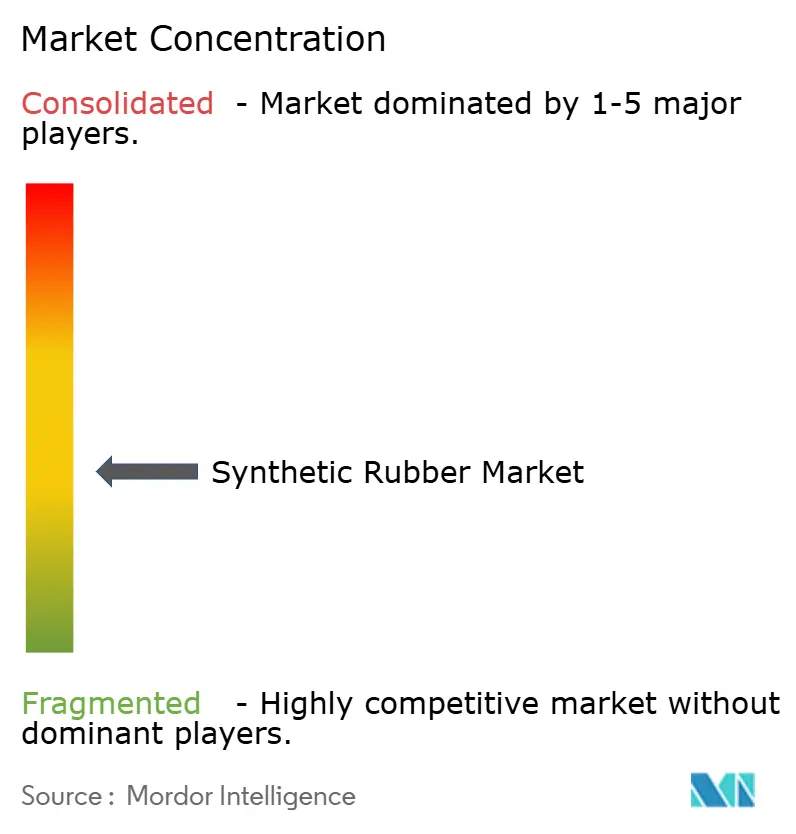
Recent Industry Developments
- December 2025: SIBUR initiated trials to replace natural rubber in tires with synthetic isoprene rubber after evaluating 300 prototype tires showing comparable performance to standard models.
- May 2025: ARLANXEO and TSRC opened an expanded NBR plant in Nantong, China, raising annual capacity to 40,000 tons.
- February 2024: Arlanxeo has announced plans to strengthen its production capabilities by building a new hydrogenated nitrile butadiene rubber (HNBR) plant in Changzhou, eastern China.
Research Methodology Framework and Report Scope
Market Definitions and Key Coverage
Our study defines the synthetic rubber market as the value generated from sales of petro-based or bio-based elastomer polymers, such as SBR, BR, EPDM, NBR, IIR, SBC, and other specialty grades, sold in primary solid or liquid form to downstream converters and end-users. Products compounded into finished tires, belts, hoses, seals, footwear, or adhesives are therefore outside the revenue pool; only first-sale material is counted.
Scope Exclusion: natural rubber is not covered.
Segmentation Overview
- By Type
- Styrene-Butadiene Rubber (SBR)
- Polybutadiene Rubber (BR)
- Ethylene-Propylene-Diene Monomer (EPDM)
- Isobutylene-Isoprene Rubber (IIR)
- Polyisoprene Rubber (IR)
- Others (NBR, CR, ACM, HNBR, etc.)
- By Manufacturing Process
- Emulsion Polymerization (E-SBR)
- Solution Polymerization (S-SBR)
- Advanced Continuous Polymerization
- By Raw Material
- Butadiene
- Isoprene
- Styrene
- Ethylene and Propylene
- Other Specialty Monomers (ACN, Chloroprene)
- By Application
- Tire and Tire Components
- Non-Tire Automobile Applications
- Industrial Goods
- Footwear
- Other Applications
- By Geography
- Asia-Pacific
- China
- India
- Japan
- South Korea
- Malaysia
- Thailand
- Vietnam
- Indonesia
- Rest of Asia-Pacific
- North America
- United States
- Canada
- Mexico
- Europe
- Germany
- United Kingdom
- France
- Italy
- Spain
- Russia
- Nordics
- Turkey
- Rest of Europe
- South America
- Brazil
- Argentina
- Colombia
- Rest of South America
- Middle East and Africa
- Saudi Arabia
- United Arab Emirates
- Qatar
- South Africa
- Egypt
- Nigeria
- Rest of Middle East and Africa
- Asia-Pacific
Detailed Research Methodology and Data Validation
Primary Research
Mordor analysts interviewed procurement managers at tire majors, compound formulators, polymer traders, and equipment suppliers across Asia-Pacific, Europe, and North America. These discussions clarified plant utilization swings, grade-specific premiums, and the pace at which EV makers shift toward solution-polymerized SBR, letting us validate desk findings and fine-tune regional assumptions.
Desk Research
We began by mapping historical supply using plant-level capacity and output disclosed by customs statistics and trade trackers, such as UN Comtrade, Eurostat-Comext, U.S. ITC DataWeb, and Japan's Ministry of Finance, to estimate cross-border flows. Industry balance sheets from the International Rubber Study Group, price indices from the U.S. Energy Information Administration, and feedstock contract data posted by ICIS further anchor feedstock-to-polymer conversion ratios.
Annual reports, 10-Ks, and investor decks from leading elastomer producers add pricing guidance, while regulatory documents (for example, EU REACH restriction dossiers on PAH content in SBR) signal demand inflections. Subscription resources in Mordor's stack, D&B Hoovers for company financials and Dow Jones Factiva for deal tracking, help us screen abnormal revenue jumps. This list is illustrative, not exhaustive, and many additional sources supported data gathering and validation.
Market-Sizing & Forecasting
A top-down reconstruction starts with global synthetic rubber production and trade volumes, which are then priced using weighted average transaction values to yield 2025 revenue. Selective bottom-up checks, capacity × utilization roll-ups for 25 key plants and sampled ASP-per-grade quotes, ensure totals remain realistic. Key variables fed into the model include butadiene feedstock prices, new light-vehicle output, replacement-tire shipments, industrial PMI trends, and regional construction spending. A multivariate regression, stress-tested through scenario analysis, projects demand to 2030; gaps where plant data were missing were closed using conservative regional penetration benchmarks discussed with experts.
Data Validation & Update Cycle
Outputs pass automated variance scans against historical series, followed by two-step analyst peer reviews. Reports refresh each year, and interim updates are triggered when feedstock shocks, capacity closures, or demand-side policy shifts move modeled values by over three percent.
Why Mordor's Synthetic Rubber Baseline Inspires Confidence
Published estimates often diverge because firms slice the market differently, choose unlike price sets, or refresh on separate cadences.
Key gap drivers include whether recycled or downstream compounded rubber is counted, how aggressively future EV tire penetration is assumed, and the currency-conversion month each provider adopts. Mordor discloses its scope, uses dual-route modeling, and refreshes annually, which reduces such drift.
Benchmark comparison
| Market Size | Anonymized source | Primary gap driver |
|---|---|---|
| USD 34.83 B (2025) | Mordor Intelligence | - |
| USD 32.84 B (2024) | Regional Consultancy A | Includes limited liquid grades only, one-year older base |
| USD 28.28 B (2024) | Global Consultancy A | Treats synthetic segment as share of total rubber, excludes specialty elastomers |
| USD 23.00 B (2022) | Trade Journal B | Historic base year, narrower application scope, bi-annual refresh |
In summary, by declaring scope up front, triangulating volumes with capacity checks, and refreshing figures yearly, Mordor delivers a balanced, transparent baseline that decision-makers can retrace and replicate with confidence.
Key Questions Answered in the Report
What is the current size of the synthetic rubber market?
The synthetic rubber market generates USD 34.83 billion in 2025.
How fast will the synthetic rubber market grow?
Revenue is projected to climb at a 4.21% CAGR, reaching USD 42.88 billion by 2030.
Which region leads synthetic rubber demand?
Asia-Pacific accounts for 57% of global demand and is expanding at 4.38% CAGR.
Why is EPDM gaining share in the synthetic rubber market?
EPDM’s weather resistance and long service life make it the preferred elastomer for renewable-energy cables, seals and gaskets, driving a 5.77% CAGR.
How are bio-based monomers influencing the synthetic rubber industry?
Partnerships such as Goodyear-Visolis are commercializing bio-isoprene that lowers carbon intensity and captures fast-growing demand from sustainability-focused OEMs.
What is the main restraint on synthetic rubber growth?
Butadiene price volatility from steam-cracker outages exerts the largest negative impact, trimming projected CAGR by 0.7%.
Page last updated on:
